Catalyst SD-WAN AppQoE DRE - Topology, Configuration, Verification
Available Languages
Download Options
Bias-Free Language
The documentation set for this product strives to use bias-free language. For the purposes of this documentation set, bias-free is defined as language that does not imply discrimination based on age, disability, gender, racial identity, ethnic identity, sexual orientation, socioeconomic status, and intersectionality. Exceptions may be present in the documentation due to language that is hardcoded in the user interfaces of the product software, language used based on RFP documentation, or language that is used by a referenced third-party product. Learn more about how Cisco is using Inclusive Language.
Contents
Introduction
This document describes how to create and configure a setup for Data Redundancy Elimination (DRE) optimization.
Background Information
This document aims to serve as a starting point for guidance on how to create and configure a setup for DRE which is part of an Integrated Application Quality of Experience (AppQoE) Solution, offering an End-to-End Consistent Policy Framework and Monitoring, for a Multitude of Deployment Use Cases.
Building blocks of AppQoE Solution:
- Forward Error Correction (FEC) and Packet Duplication (PD): Addresses Packet Loss issues. See for FEC.
- TCP optimization: Addresses WAN latency issues. See for a single-sided TCP Opt Use Case.
- DRE optimization: Addresses Low Bandwidth issues. Typically DRE Optimization is used together with TCP Optimization.
Existing CCO DRE documentation does not contain a full end-to-end process description. This document provides a step-by-step end-to-end description of the DRE solution.
A deep technical explanation of DRE functionality is out of the scope of this article. If you want to learn more about technical details and DRE functionality, please use this documentation.
DRE Optimization
DRE is a dual-sided solution that removes redundant data by caching previously seen patterns. Combined with the Lempel–Ziv–Welch (LZW) algorithm, which provides compression to reduce the amount of data over WAN, the DRE feature offers a fully secure and integrated solution with Unified Threat Defense (UTD) and Secure Sockets Layer (SSL) proxy.
It is Application and Protocol agnostic and is a Cloud-ready solution which offers around 60-90% WAN traffic reduction.
Different deployment scenarios are supported to achieve a scalable solution.
- The integrated solution provides a one-box solution for deploying branch services, termed as an Integrated Service node (ISN).
- External Service Nodes (ESN) are decoupled from intercepting edge routers or Service Controller (SC) in External Service Node deployment, typically at Data Centers and Hubs. Redirection of flows based on application traffic is achieved using a Data Policy.
Control Connections

Note: The ESN does not form any control connection with the Controller (formerly known as vSmart). The ESN has a control connection to the SD-WAN Manager.
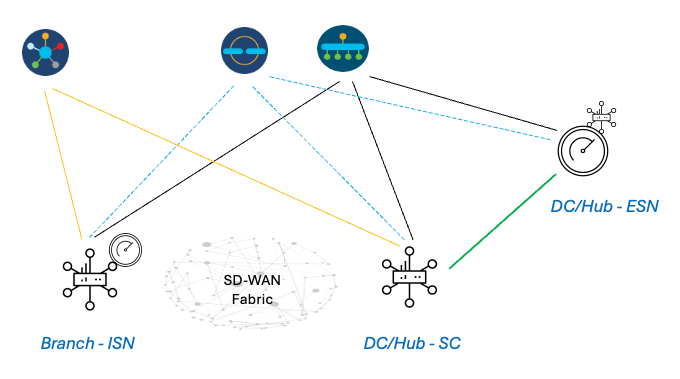
Steps to Build an AppQoE DRE Setup with ISN and ESN
1. System (Interfaces and Hardware) and Topology
1.1. Topology and Interfaces
The ESN requires the following interfaces:
- A VPN0 Interface connectivity to the Controllers (Manager and Validator [transient]).
Connectivity from ESN to Controllers can be directly or via SC. The recommendation is via SC since this avoids the need for an additional WAN circuit on the ESN.
- Another VPN0 Interface for connectivity to the Service Controller.
- Optional: A VPN512 Management interface.
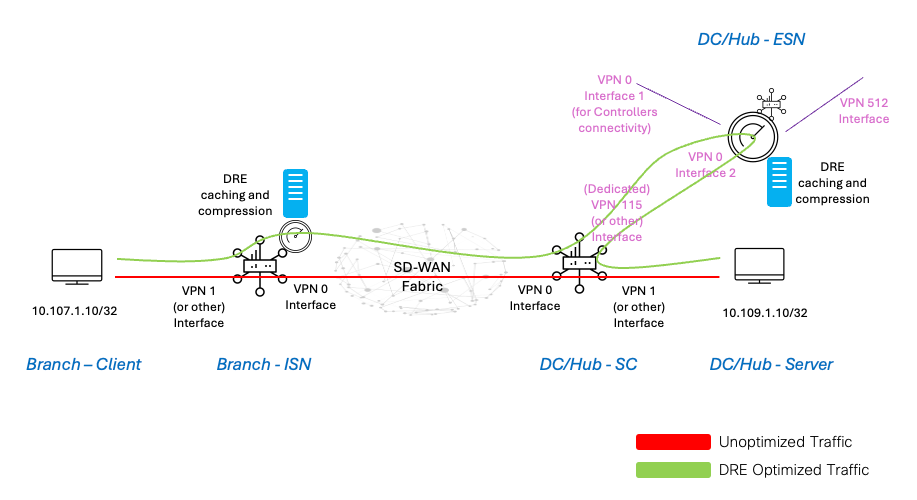
1.2. Disk Requirement
For a lab setup, a 150GB disk is good enough, for the DRE optimization to work.
This holds good only for functional verification in a lab environment, and is not meant for production. For accurate disk and other recommendations, please check this CCO link.

Note: This additional disk requirement is only for the ISN and ESN. It is not required on SC.
1.3. Adding Devices to SD-WAN Fabric
- Using templates (available from 20.6/17.6 onwards): AppQoe Feature template which can be specified in the Device Template as an Additional Template.
- Using Configuration Groups (available from 20.14/17.14 onwards): AppQoE Feature parcel available in Service/LAN profile in Configuration Group.
1.4. C8000v Details
If you are using c8kv, please ensure to enable app-heavy CPU profile configuration. Useful article.
2. Branch: AppQoE ISN Configuration
Create an AppQoE feature template (using templates as shown here) for the device model.
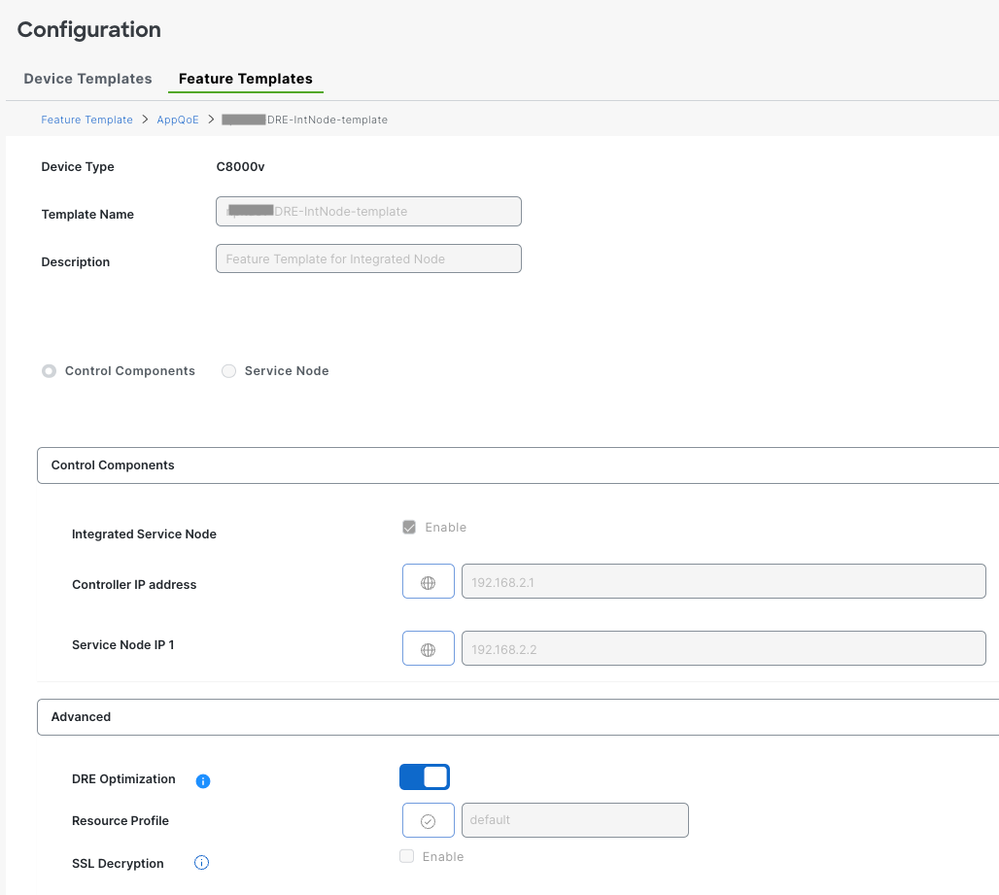
Then, specify this Feature template in the Device template.

3. DC/Hub: AppQoE ESN Configuration
Create an AppQoE Feature Template for the device model.
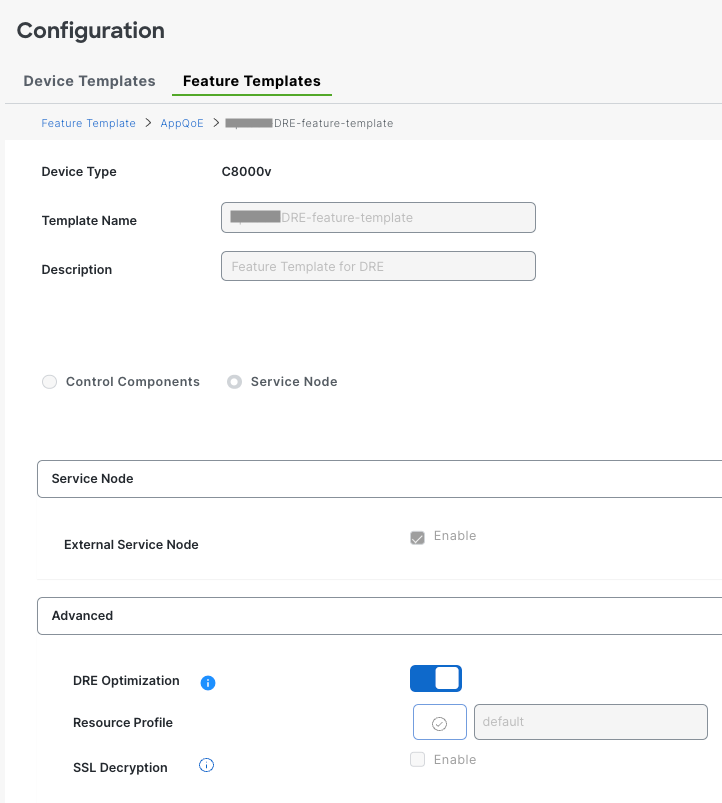
Then, specify this Feature template in the Device template.

4. DC/Hub: AppQoE SC Configuration
Create an AppQoE Feature Template for the device model.
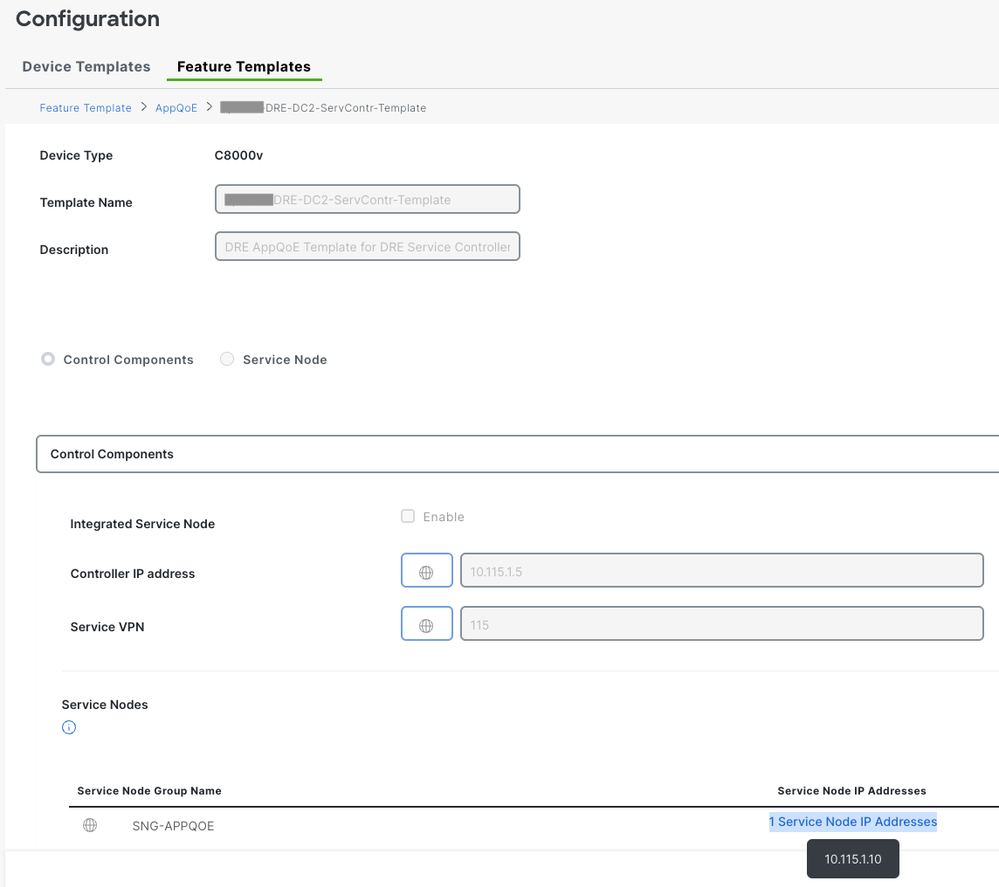
Then, specify this Feature template in the Device template.

5. Centralized Traffic Data Policy
- Two different policies are required: one for the Internal Service Node (ISN) and the second for the Service Controller (SC). See the difference below.
- The Policy direction must be "All" for both
- The Service-node-group must be blank for ISN and specified for the SC.
- DRE optimization is typically used along with TCP optimization.
In this example, a Web Client on a Branch location is defined and a Web Server on the DC site, you might want to adjust it for your traffic of interest accordingly.
A. Branch ISN
UI - Template
Sequence 1 - from Client 10.107.1.10 to Server 10.109.1.10:

Sequence 2 - from Server back to Client:
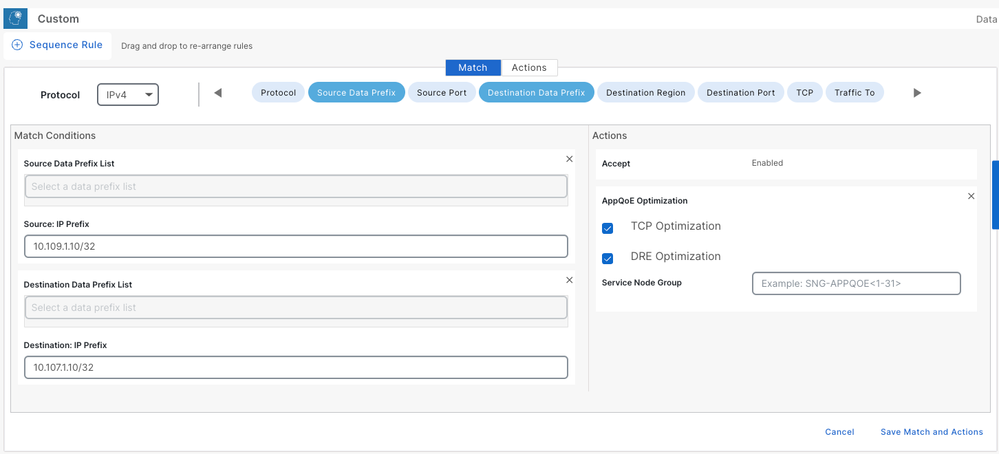
CLI:
ISN# show sdwan policy from-vsmart
from-vsmart data-policy _CorpVPN_DRE-data-policy-ISN-2
direction all
vpn-list CorpVPN
sequence 1
match
source-ip 10.107.1.10/32
destination-ip 10.109.1.10/32
action accept
tcp-optimization
dre-optimization
sequence 11
match
source-ip 10.109.1.10/32
destination-ip 10.107.1.10/32
action accept
tcp-optimization
dre-optimization
default-action accept
from-vsmart lists vpn-list CorpVPN
vpn 1
B. DC/Hub SC
UI - Template
Sequence 1:
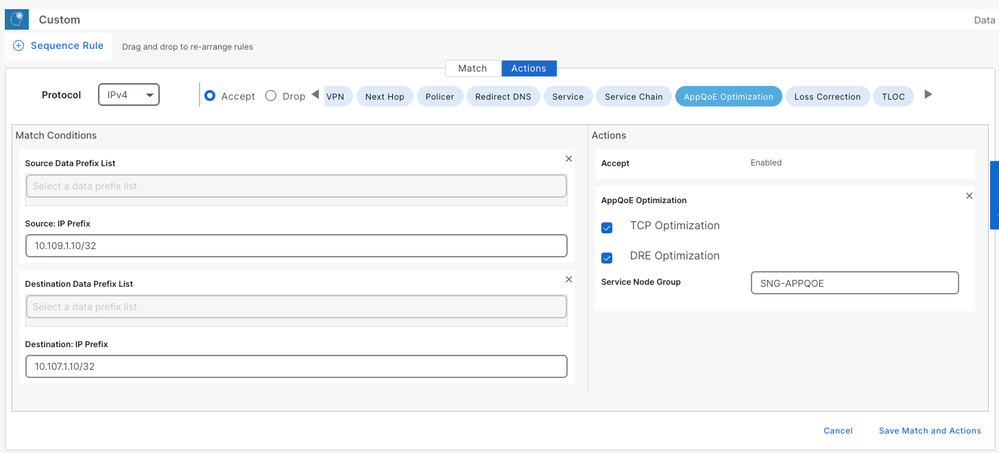
Sequence 2:
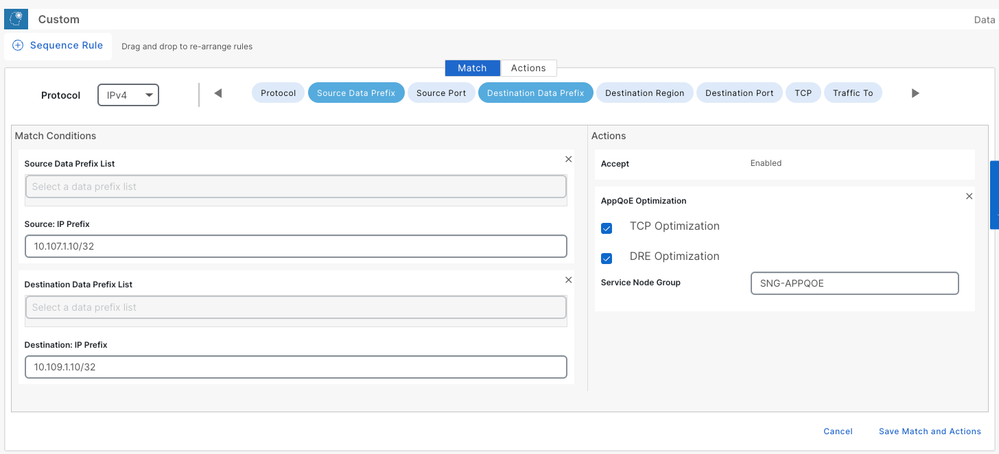
CLI:
SC# show sdwan policy from-vsmart
from-vsmart data-policy _CorpVPN_DRE-data-policy-SC_ESN-2
direction all
vpn-list CorpVPN
sequence 1
match
source-ip 10.107.1.10/32
destination-ip 10.109.1.10/32
action accept
tcp-optimization
dre-optimization
service-node-group SNG-APPQOE
sequence 11
match
source-ip 10.109.1.10/32
destination-ip 10.107.1.10/32
action accept
tcp-optimization
dre-optimization
service-node-group SNG-APPQOE
default-action accept
from-vsmart lists vpn-list CorpVPN
vpn 1
Verification - CLI
Branch ISN
ISN# show sdwan appqoe dreopt status
DRE ID : 52:54:dd:2a:74:d7-018eafaa99e1-f9ff51aa
DRE uptime : 04:10:59:59
Health status : GREEN
Health status change reason : None
Last health status change time : 04:10:59:59
Last health status notification sent time : 1 second
DRE cache status : Active
Disk cache usage : 2%
Disk latency : 25 ms
Active alarms:
None
Configuration:
Profile type : S
Maximum connections : 750
Maximum fanout : 35
Disk size : 60 GB
Memory size : 2048 MB
CPU cores : 1
Disk encryption : ON
ISN# show sdwan appqoe flow active
T:TCP, S:SSL, U:UTD, D:DRE
Flow ID VPN ID Source IP Port Destination IP Port Tx Bytes Rx Bytes Services
--------------------------------------------------------------------------------------------------------------
54382538667 1 10.107.1.10 55340 10.109.1.10 80 263663268 640416 TD
ISN# show sdwan appqoe dreopt statistics
Total connections : 4
Max concurrent connections : 1
Current active connections : 1
Total connection resets : 0
Total original bytes : 3570 MB
Total optimized bytes : 1633 MB
Overall reduction ratio : 54%
Disk size used : 2%
Cache details:
Cache status : Active
Cache Size : 59132 MB
Cache used : 2%
Oldest data in cache : 01:22:02:49
Replaced(last hour): size : 0 MB
DC/Hub SC
SC# show service-insertion type appqoe service-node-group
Service Node Group name : SNG-APPQOE
Service Context : appqoe/1
Member Service Node count : 1
Service Node (SN) : 10.115.1.10
Auto discovered : No
SN belongs to SNG : SNG-APPQOE
Current status of SN : Alive
System IP : 10.1.90.2
Site ID : 90
Time current status was reached : Sat Apr 6 07:26:16 2024
Cluster protocol VPATH version : 2 (Bitmap recvd: 3)
Cluster protocol incarnation number : 1
Cluster protocol last sent sequence number : 1714282683
Cluster protocol last received sequence number: 1931795
Cluster protocol last received ack number : 1714282682
Health Markers:
AO Load State
tcp GREEN 0%
ssl RED/NOT AVAILABLE
dre GREEN 0%
http RED/NOT AVAILABLE
utd chnl RED/NOT AVAILABLEDC/Hub ESN
ESN# show sdwan appqoe dreopt status
DRE ID : 52:54:dd:c3:40:17-018eb15f4fc3-49ee2d0f
DRE uptime : 04:11:28:50
Health status : GREEN
Health status change reason : None
Last health status change time : 04:11:28:50
Last health status notification sent time : 1 second
DRE cache status : Active
Disk cache usage : 2%
Disk latency : 10 ms
Active alarms:
None
Configuration:
Profile type : S
Maximum connections : 750
Maximum fanout : 35
Disk size : 60 GB
Memory size : 2048 MB
CPU cores : 1
Disk encryption : ON
ESN# show sdwan appqoe flow active
T:TCP, S:SSL, U:UTD, D:DRE
Flow ID VPN ID Source IP Port Destination IP Port Tx Bytes Rx Bytes Services
--------------------------------------------------------------------------------------------------------------
20022800299 1 10.107.1.10 55340 10.109.1.10 80 2998777 1074725760 TD
ESN# show sdwan appqoe dreopt statistics
Total connections : 4
Max concurrent connections : 1
Current active connections : 1
Total connection resets : 0
Total original bytes : 4294 MB
Total optimized bytes : 1634 MB
Overall reduction ratio : 61%
Disk size used : 2%
Cache details:
Cache status : Active
Cache Size : 59132 MB
Cache used : 2%
Oldest data in cache : 01:22:04:08
Replaced(last hour): size : 0 MB
Verification - Dashboard
To view the AppQoE DRE data in the SD-WAN Manager Device dashboard, ensure the following:
- Controllers and Devices time is synchronized by configuring Network Time Protocol (NTP). You can also use the
Clock setcommand to set the clock manually. - Add these CLIs to the Device configuration (ISN/SC/ESN):
policy ip visibility features multi-sn enable
policy ip visibility features dre enable
policy ip visibility features sslproxy enable - (for SSL traffic)

Note: On-demand Troubleshooting should be enabled to view these dashboards. Note that the dashboard screens shown here do not show real-time information.
To get the latest data, you might want to navigate to Tools > On Demand Troubleshooting , select the appropriate Device and "DPI" as Data Type and retrieve the DPI statistics for the last 3 hours as shown here:

Branch ISN
Approximately 900MB of data was downloaded (3 x 200MB files and 3 x 100MB files) - Original Traffic (YELLOW).
The optimization resulted in only 8.07MB of traffic sent over the WAN, around 90% bandwidth usage reduction - Optimized Traffic (BLUE).
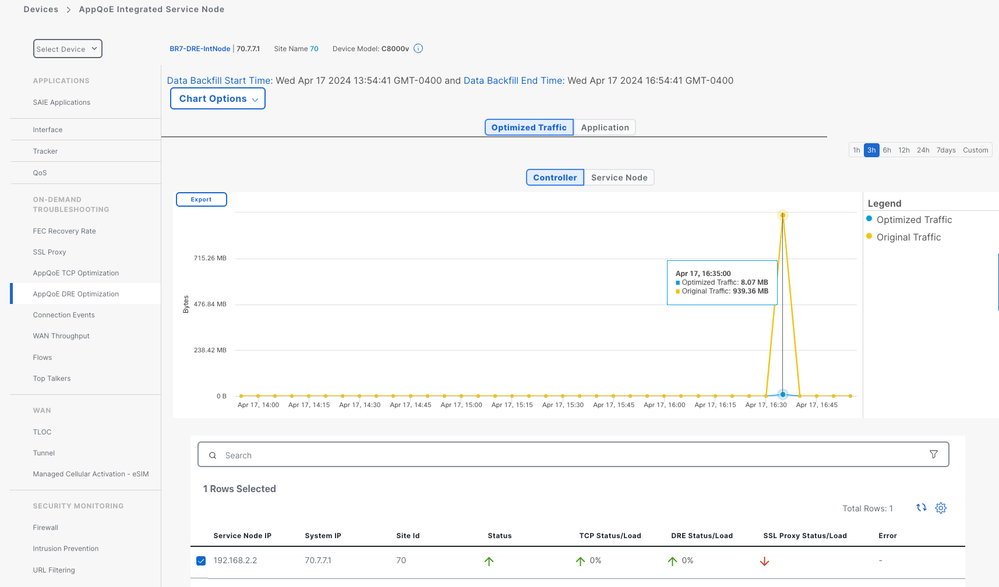
DC/Hub SC
If there are multiple ESNs, then the Controllertab shows the cumulative data and the Service Nodetab shows the individual ESN data.
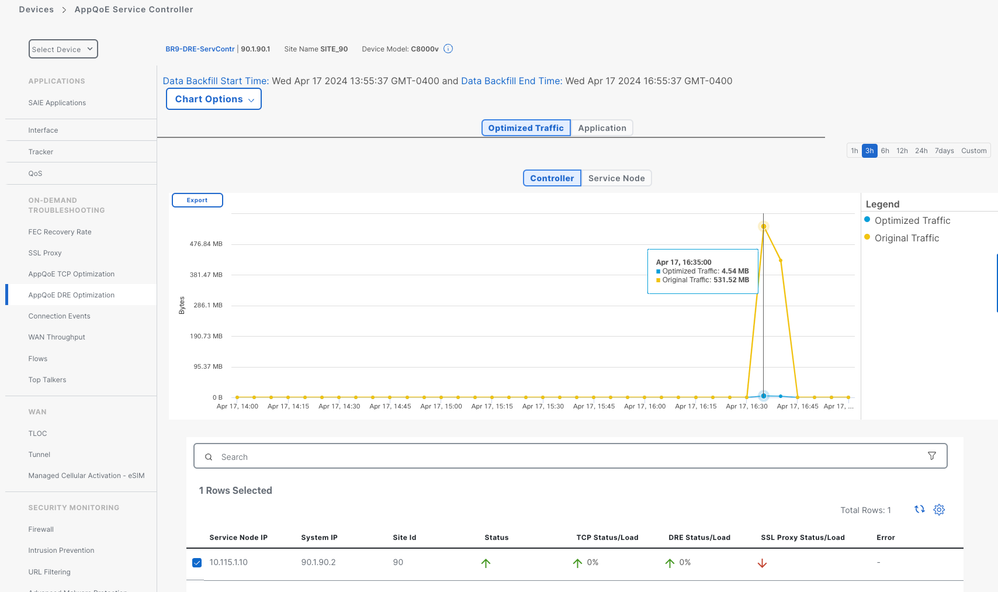
DC/Hub ESN
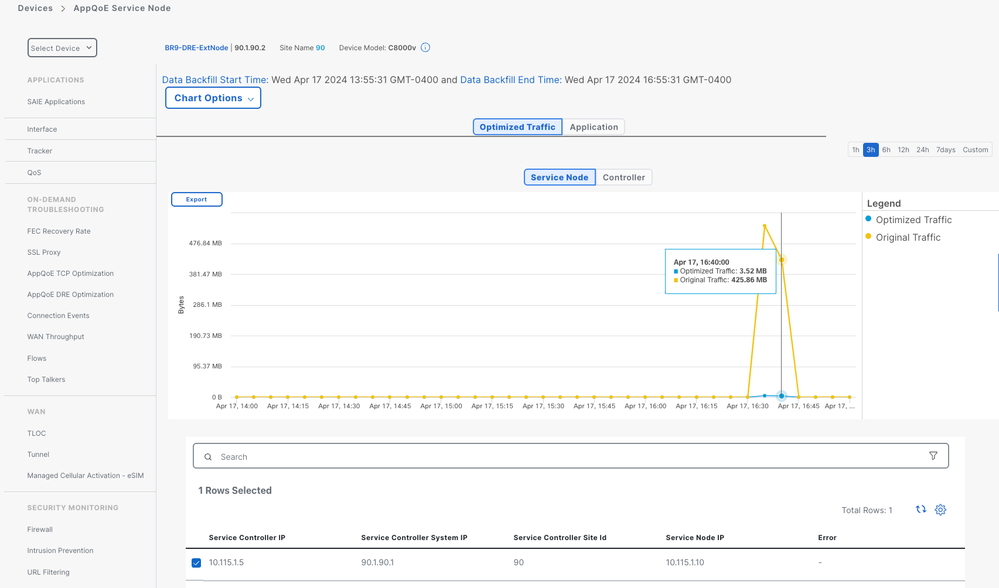
Revision History
| Revision | Publish Date | Comments |
|---|---|---|
1.0 |
30-Apr-2024 |
Initial Release |
Contributed by
- Prashanth RaghavendraCisco Technical Leader
- Nikolai PitaevCisco Technical Leader
Contact Cisco
- Open a Support Case

- (Requires a Cisco Service Contract)
 Feedback
Feedback